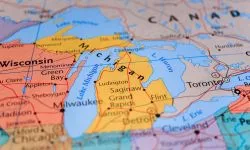Michigan’s redistricting panel is slated to begin approving new state legislative and congressional maps Tuesday after months of map-drawing and controversy.
The 13-member panel is supposed to choose from 15 proposed maps drafted by the group last month.
“The whole point of going through this long and very ambitious, democratic process has been to make sure that we have maps that are fair,” Susan Smith, the redistricting director of the League of Women Voters of Michigan, told Bridge.
The Michigan’s Independent Citizens Redistricting Commission is scheduled to start deliberations on the maps on Tuesday and could continue to finalize them until Thursday.
The vote is the culmination of a process that began in 2018, when voters changed the state constitution and created a panel to handle the drawing of legislative boundaries every 10 years.
For years, the party in power in Lansing has drawn the districts after the decennial Census, a process that allowed Republicans to keep control of the Legislature and create what a federal court deemed a “gerrymander of historic proportions.”
Proposed maps would give Democrats — the party that receives the most statewide votes — an advantage in the majority of the seats in the state House, state Senate and Michigan’s congressional delegation.
If voting patterns hold from 2020, Democrats would have an advantage to gain control of the state Legislature in 2022. Republicans have been in the majority in the state Senate since the 1980s, while the congressional delegation is now split 7-7 and losing a district because of stagnant population.
Once the maps are formalized, lawsuits challenging the districts are likely. Some Black Democrats have vowed to sue because the current proposals reduce the number of majority-minority districts.
Partisan fairness?
The commission spent weeks in public meetings and forums drafting the maps, which unlike ones put together by lawmakers in years past, do not take incumbency into account.
A Bridge Michigan analysis found there are up to three dozen proposed state House and state Senate and U.S. House districts without an incumbent, and another 11 that would have more than one incumbent.
The commission crafted the maps using a ranked criteria, along with partisan fairness metrics based on previous election results, to draw the new districts.
Unlike previous maps, the districts typically do not stay within county or city lines. The commission did so to try to “unpack” districts — ones that are lopsided for one party — and make them more fair, but doing so caused a backlash from Black voters and community activists.
The redistricting commission contends minorities can elect candidates of their choosing with districts that aren’t overwhelmingly composed of people of color.
So, they have lowered the number of majority-minority districts (districts where over 51 percent of the population belongs to a racial minority group) from 17 in the state House, Senate and congressional delegation to a handful.
Others have criticized how the commission has split neighborhoods, despite their status of community of interest or “populations that share cultural or historical characteristics or economic interests.”
Uncertain legacy
Tony Daunt, the executive director of conservative advocacy group FAIR Maps, told Bridge Michigan the commission’s work has been an “abject, laughable failure.”
He questioned the commission’s methods to achieve partisan fair maps.
“These are all things — Voting Rights Act, communities of interest— that are above partisan fairness in importance, according to the Constitution, but there was never a consistent application,” Daunt said.
Ultimately, the commission’s work will be judged on whether it withstands legal challenges, said Adrian Hemond, a Democratic strategist.
“For all of the complaints about the way that legislative Republicans did the last couple of reapportionment in our state — and I was one of those people who was complaining about those maps being unfair — they stood up in court,” Hemond said.
But others point that the commission has already made history by making a process that was largely secretive a public one. The commission has live streamed all of its meetings (over 135), and has taken public comment in person, via the online portal, and through regular mail.
“Even the bumpy parts have kind of had to be resolved by the commission out in the open,” said Nancy Wang, executive director of Voters Not Politicians, the grassroots group that advocated for the commission in 2018.
“They’ve had to answer to the people. They’ve had to really take into account public comment.”
Still, the commission has been criticized heavily for its decision in October to meet behind closed doors to discuss two Voting Rights Act-related memos.
Bridge Michigan, The Detroit News, Detroit Free Press, and the Michigan Press Association sued the commission with the Michigan Supreme Court earlier this month to force them to release the memos.
Last week, a divided Michigan Supreme Court ruled that the commission had to release the memos and notes from its private meeting.
From the Non-partisan Newsroom of BridgeMI in Lansing






